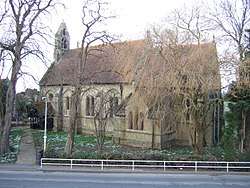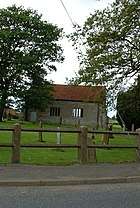Guyhirn
Guyhirn is a village near the town of Wisbech in Cambridgeshire, England. It is on the northern bank of the River Nene, at the junction of the A141 with the A47. The population is included in the civil parish of Wisbech St Mary.
| Guyhirn | |
|---|---|
 Church of St Mary Magdalene | |
 Guyhirn Location within Cambridgeshire | |
| OS grid reference | TF399041 |
| Shire county | |
| Region | |
| Country | England |
| Sovereign state | United Kingdom |
| Post town | WISBECH |
| Postcode district | PE13 |
History
According to A Dictionary of British Place Names, Guyhirn, which was 'La Gyerne' in 1275, derives from the Old French 'guie', which means "a guide" (referencing the control of tidal flow or a "salt-water ditch"), with the Old English 'hyrne', which means an "angle or corner of land".[1]
The village is on the opposite bank of the River Nene to Ring's End where John Morton, Bishop of Ely, erected a tower house to oversee his new drain, Morton's Leam, one of the oldest fenland drains, in the late fifteenth century.[2][3]
Guyhirne railway station on the Great Northern and Great Eastern Joint Railway was opened in 1867. The railway required the building of the first bridge across Morton's Leam and the River Nene at Guyhirn. The railway bridge incorporated a foot bridge, which allowed free passage between Guyhirn and Ring's End.
The first road bridge across the River Nene at Guyhirn was opened in 1926.[4]
Religion

The first chapel in Guyhirn originated in a chantry founded in 1337 by John de Reddik.[5]
Between the seventeenth and early nineteenth centuries, Guyhirn was home to a sect of religious dissenters known as the Culymites. They were named after their founder, David Culy, the son of a Huguenot family[6] who had moved to Guyhirn, and who became known as the 'Bishop of Guyhirn'. Their beliefs were said to differ little from those of Anabaptists.[7] It has been estimated that his followers came to number more than 700.[8]
A Methodist Chapel was built in 1849 and rebuilt in 1868 by the Primitive Methodists with pews for 147 worshipers. This building has been demolished.[9]
The parish church of St Mary Magdalene was built in 1878, by architect George Gilbert Scott.[10][11] Since 31 October 1983 it has been designated a Grade II listed building.[12] Now a redundant church, it was put for sale in 2018 for £75,000.[13]
Guyhirn Puritan Chapel, also known as Guyhirn Old Church, or the Chapel of Ease, is a small rectangular building constructed of brick and Barnack stone, with five windows of clear leaded glass set in stone mullions. Designed at the end of the Cromwellian Commonwealth, it was not completed until 1660 when the Restoration had returned Anglicanism as the official religious observance and because of this the Chapel was probably never consecrated. It is recorded in the National Heritage List for England as a designated Grade II* listed building, and is in the care of the Churches Conservation Trust, and the 'Friends of the Guyhirn Chapel of Ease' formed in 1973 under the presidency of Sir John Betjeman, and later, Edward Storey.[14][15][16]
See also
References
- Mills, Anthony David (2003); A Dictionary of British Place Names, Oxford University Press, revised edition (2011), p.217. ISBN 019960908X
- "Guyhirn History", Guyhirn-online, archived from the original on 4 August 2009, retrieved 8 October 2019
- "Geograph:: The Nene Washes [267 photos]". www.geograph.org.uk. Retrieved 25 June 2020.
- "Guyhirn Bridge - Roader's Digest: The SABRE Wiki". www.sabre-roads.org.uk. Retrieved 25 June 2020.
- "Wisbech Hundred: Wisbech St. Mary | British History Online". www.british-history.ac.uk. Retrieved 26 June 2020.
- "Culy, David (d. c. 1725), Independent minister". Oxford Dictionary of National Biography. doi:10.1093/ref:odnb/9780198614128.001.0001/odnb-9780198614128-e-6886. Retrieved 26 June 2020.
- Peterborough [Eng.]G.C.Caster; Saunders, W. H. Bernard; Sweeting, W. D. (Walter Debenham) (1889). Fenland notes & queries. George A. Smathers Libraries University of Florida. Peterborough [Eng.] G.C.Caster.
- Jones, Harry. (2004). Free-thinkers & trouble-makers : Fenland dissenters. Spinks, Judi., Wisbech Society. Norfolk: Published by the Wisbech Society & Preservation Trust. ISBN 0-9519220-7-6. OCLC 69785510.
- "Guyhirn Primitive Methodist Chapel". My Primitive Methodists. Retrieved 26 June 2020.
- "Guyhirn, St Mary Magdalene". www.druidic.org. Retrieved 20 January 2019.
- "Church". Guyhirn-online. Archived from the original on 4 August 2009. Retrieved 20 January 2019.
- "Church of St Mary Magdalene, Guyhirn, Cambridgeshire". britishlistedbuildings.co.uk. Retrieved 20 January 2019.
- "Historic Grade II listed former church in Guyhirn up for sale for £75,000". www.wisbechstandard.co.uk. Retrieved 20 January 2019.
- Guyhirn Chapel of Ease, Guyhirn-Online, archived from the original on 4 August 2009, retrieved 9 March 2011
- Historic England, "Chapel of Ease, Wisbech St Mary (1331986)", National Heritage List for England, retrieved 26 March 2015
- Guyhirn Chapel, Guyhirn Chapel, Cambridgeshire, Churches Conservation Trust, retrieved 9 December 2016
External links
![]()